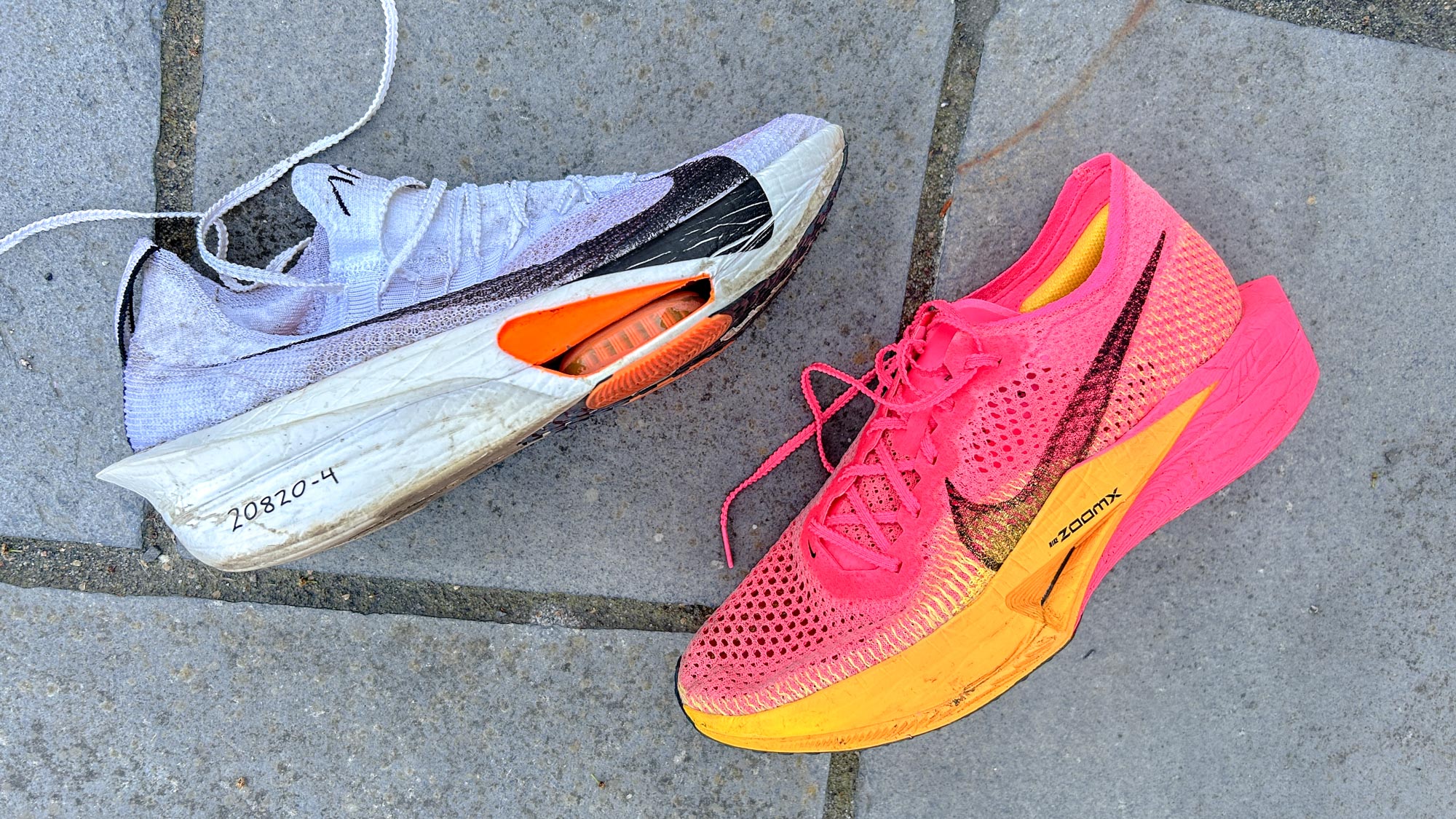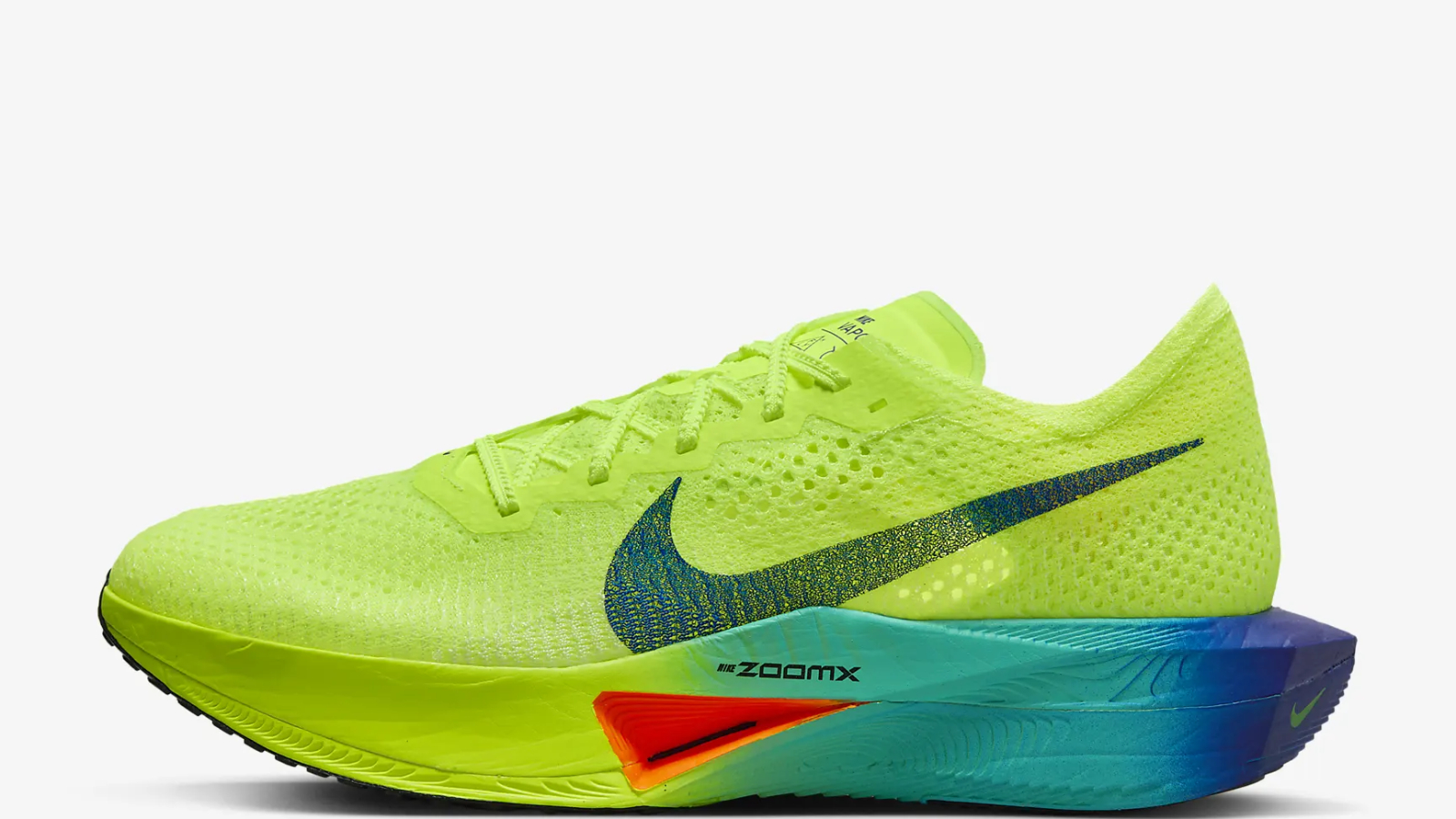Nike Vaporfly 3 vs Nike Alphafly 3 — which should you buy?


The Nike Alphafly 3 is a bouncier, more propulsive shoe than the Vaporfly 3 and more comfortable over long distances, but it's also heavier and more expensive.
Pros
- Comfortable, efficient ride
- Very propulsive ride
- Extra pop from Air Zoom pods
Cons
- More expensive than Vaporfly 3
- Heavier than Vaporfly 3
The Nike Vaporfly 3 and Nike Alphafly 3 are two of the best carbon plate running shoes available, and picking up either will put you in a great position to PR in your next race — as long as you’ve done the training for it.
There are a lot of similarities between the two shoes, but they do have key differences that have been drawn out during my extensive testing of both shoes. Before diving into the pros and cons of each, it’s worth noting that both the Vaporfly and Alphafly are racing shoes.
So, if you’re looking for more of an all-rounder to use for daily training, something like the Nike Pegasus 40 would be a better pick. The Pegasus is also one of the best Nike running shoes and has a more stable and durable design, and is a lot cheaper too.
Nike Vaporfly 3 vs Nike Alphafly 3: price and availability
The Nike Vaporfly 3 is the older of the two shoes, having come out in March 2023, while the Nike Alphafly 3 was launched in January 2024. The Alphafly is the more expensive shoe, costing $285, while the Vaporfly 3 is $250.
Both shoes are available from Nike and third-party retailers, but availability of the Alphafly 3 has been more limited since its launch. As the older shoe, the Vaporfly 3 is easier to get hold of and more likely to appear in sales.
Nike recently launched its 'Blueprint' pack, which contains special editions of various shoes in its line-up that it consider among its most technologically-advanced. Interestingly the Alphafly 3 is included in the pack, but the Vaporfly 3 isn't, which is a shame as the white, blue and orange colorway used for the collection is lovely.
Nike Vaporfly 3 vs Nike Alphafly 3: design and fit

Both shoes have an 8mm heel-to-toe drop and a stack height that hits the 40mm limit set by World Athletics at the heel. The Alphafly 3 is the heavier shoe, weighing 7.7oz in my US size 10, whereas the Vaporfly 3 is 7.3oz in the same size.
Get instant access to breaking news, the hottest reviews, great deals and helpful tips.
The main difference in the design of the two shoes is the Air Zoom pods that are used under the forefoot of the Alphafly 3. These pods are firmer and a little more responsive than the ZoomX foam used for the rest of the Alphafly’s midsole, and the entirety of the Vaporfly’s midsole.
There are also differences in the carbon plate running through the two shoes. It’s wider on the Alphafly to create a little more stability, and the Alphafly is a wider shoe than the Vaporfly in general, which contributes to it being slightly heavier.
Both shoes have cutouts in the midsole to reduce weight. The Alphafly’s is larger and runs most of the length of the shoe. This is different to the central cutout on past models of the Alphafly, which separated the foam under the forefoot and heel. The continuous midsole of the Alphafly 3 makes it more similar to the Vaporfly 3 in ride feel.

The Alphafly 3 has an Atomknit 3.0 upper, while the Vaporfly 3 uses Flyknit. Both uppers are lightweight and have an open weave that makes them very breathable. The Alphafly has a little more structure and padding around the heel and a bootie-style fit, while the Vapofly has a more traditional tongue and a thin strip of foam at the heel to hold the achilles.
Both shoes fit me well in my normal running shoe size, but I prefer the heel design on the Alphafly. The strip of foam on the Vaporfly sometimes irritates my achilles tendon during runs, and I’m always tempted to cut it out entirely, whereas I don’t get these problems from the padding on the Alphafly.
The Alphafly 3 has a more substantial and durable outsole than the Vaporfly, with good rubber coverage on the forefoot and small sections at the heel that aren’t showing any signs of wear after 80 miles.
The thin rubber used on the Vaporfly is peeling off at the heel of my shoes after around 100 miles of use, and in general the bottom of the shoe is showing a lot more wear than the Alphafly, which I think will be the more durable shoe overall.
Nike Vaporfly 3 vs Nike Alphafly 3: running performance

I have done a lot of training and racing on both shoes, having run 100 miles in the Vaporfly including the London Marathon 2024 and a 5K race, and 80 miles in the Alphafly including 5K and 10K races. Both are terrific shoes, and among the best carbon plate running shoes available from any brand.
The Vaporfly does feel lighter and nimbler on the run, with its narrower design making it seem a bit more agile when doing short reps and races, especially on twisty courses. It is a bouncy shoe and certainly comfortable enough for a marathon, but when it comes to spring and comfort, the Alphafly 3 does have the edge.
While the stack heights of the shoes are the same, the Alphafly feels more cushioned and the midsole seems ‘deeper’. It has a more propulsive, bouncy ride than the Vaporfly 3 as a result.
The Alphafly 3 is actually a little less bouncy than past models of the shoe, but the new continuous midsole creates a faster heel-to-toe transition that moves you onto the Air Zoom pods more effectively, and you get more pop from the pods as a result.

With both shoes you get a sensation of being tipped-forward by the design and plate in the midsole, and both roll you onto your toes quickly with each stride. The Alphafly’s pods are a noticeable difference between the rides of the two shoes. When I did an interval session using the two shoes in turn, the firmer, more responsive toe-off you get from the pods in the Alphafly is noticeable.
Over the course of long runs the Alphafly 3 feels a little smoother as well, and it’s easier to lock into your race pace with the shoe and hold. The lightness of the Vaporfly 3 makes it better for quick accelerations though, and it’s easier to round corners at speed and accelerate out of them.
Neither shoe is particularly stable, though the Alphafly 3 is a little more so, and as racing shoes with soft foams that are designed purely for running fast, neither is a good shoe for general use and walking.
Nike Vaporfly 3 vs Nike Alphafly 3: which is best for you?
I rate both of these shoes very highly, but think the Alphafly 3 is the better all-round racing shoe, and it’s particularly good for marathons. The Vaporfly is also an excellent racer for any distance but isn’t quite as propulsive as the Alphafly, though its lighter design gives it a small edge for shorter events like 5Ks.
The Vaporfly 3 is cheaper though, and more likely to appear in sales. If money is no object I’d buy the Alphafly, but if you can pick the Vaporfly 3 up at a discounted price it offers better value.
That is undermined a little by the less durable outsole on the shoe compared with the Alphafly 3, but if you just use the shoe for races and the occasional key training session the Vaporfly 3 will still last a few hundred miles.

Nick Harris-Fry is an experienced health and fitness journalist, writing professionally since 2012. He spent nine years working on the Coach magazine and website before moving to the fitness team at Tom’s Guide in 2024. Nick is a keen runner and also the founder of YouTube channel The Run Testers, which specialises in reviewing running shoes, watches, headphones and other gear.
Nick ran his first marathon in 2016 and became obsessed with the sport. He now has PBs of 2hr 25min for the marathon and 15min 30sec for 5K. Nick is also a qualified Run Leader in the UK.
Nick is an established expert in the fitness area and along with writing for many publications, including Live Science, Expert Reviews, Wareable, Coach and Get Sweat Go, he has been quoted on The Guardian and The Independent.

